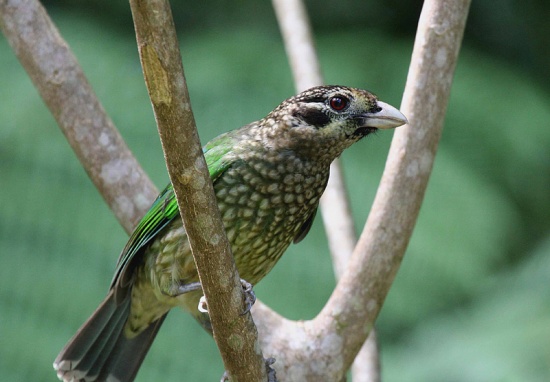(Taxonomy) |
m (→Taxonomy) |
||
| Line 26: | Line 26: | ||
* ''A. m. melanotis'' on Aru Islands and Trans-Fly lowlands, south [[New Guinea]] | * ''A. m. melanotis'' on Aru Islands and Trans-Fly lowlands, south [[New Guinea]] | ||
* ''A. m. melanocephalus'' in mountains of southeast [[New Guinea]] | * ''A. m. melanocephalus'' in mountains of southeast [[New Guinea]] | ||
| − | Some populations in [[New Guinea]] are not yet assigned to a subspecies. | + | Some populations in [[New Guinea]] are not yet assigned to a subspecies.<br /> |
| + | ''A. m. maculosus'', formerly accepted by some authorities is a synonym of ''Ailuroedus crassirostris maculosus'' ([[Green Catbird]]). | ||
==Habitat== | ==Habitat== | ||
Revision as of 15:45, 16 September 2011
Alternative names: Black-eared Catbird; Black-cheeked Catbird
- Ailuroedus melanotis
Identification
29cm.
- Emerald green plumage, paler below
- Heavy whitish spotting on head, underparts and mantle
- Whitish head with black markings (very dark in jobiensis or melanotis, much paler in Australia)
- Tail, greater coverts and secondaries finely tipped white
- Whitish bill
- Red eye
Sexes similar, females are slightly smaller
Similar Species
Green Catbird can appear similar but has a more or less uniform green head. White-eared Catbird is smaller, has an unmarked brown crown and a distinctive white ear-patch.
Distribution
Patchily distributed in New Guinea and adjacent islands and in Queensland, Australia.
Common and widespread in its range.
Taxonomy
Probably forms a superspecies with Green Catbird and sometimes regarded as conspecific. However, new studies support the full species status. Eight subspecies:[1]
- A. m. misolienis on Misool, West Papuan Islands
- A. m. arfakianus in the mountains of Vogelkop and other parts of northwest New Guinea
- A. m. jobiensis in mountains of north New Guinea
- A. m. facialis in mountains of west New Guinea
- A. m. guttaticollis in mountains of northeast New Guinea
- A. m. astigmaticus in mountains of Huon Peninsula, northeast New Guinea
- A. m. melanotis on Aru Islands and Trans-Fly lowlands, south New Guinea
- A. m. melanocephalus in mountains of southeast New Guinea
Some populations in New Guinea are not yet assigned to a subspecies.
A. m. maculosus, formerly accepted by some authorities is a synonym of Ailuroedus crassirostris maculosus (Green Catbird).
Habitat
Tropical rainforest in lowlands and mountains. Also tall secondary growth, gardens and orchards. Occurs from sea-level up to 2250 m in New Guinea, up to 1540m in Australia.
Behaviour
Feeds mostly on fruits. Takes also some flowers, stems, sap and animals (mostly arthropods). Maculosus in Australia is known to take bird eggs and nestlings.
Known to cache fruit in niches for later. Forages singly, in pairs, family groups or mixed-species flocks with other fruit-eating birds.
Breeding season August to January in New Guinea, October to December in Australia. They form long-standing monogamous pairs. They make a bowl-shaped nest of sticks and leaves about 2-10m above the ground. 1-3 plain cream coloured eggs are laid. Incubation is 19-25 days, and nestlings fledge at about 18-22 days.
A resident species.
Vocalisations
The name Catbird derives from its distinctive call, like meowing heard mainly at dawn and dusk.
References
- Clements, JF. 2011. The Clements Checklist of Birds of the World. 6th ed., with updates to August 2011. Ithaca: Cornell Univ. Press. ISBN 978-0801445019. Spreadsheet available at http://www.birds.cornell.edu/clementschecklist/downloadable-clements-checklist
- Del Hoyo, J, A Elliott, and D Christie, eds. 2009. Handbook of the Birds of the World. Volume 14: Bush-shrikes to Old World Sparrows. Barcelona: Lynx Edicions. ISBN 978-8496553507
- Simpson, K and N Day. 1998. Field Guide to the Birds of Australia. London: Christopher Helm. ISBN 0-7136-4877-5
Recommended Citation
- BirdForum Opus contributors. (2025) Spotted Catbird. In: BirdForum, the forum for wild birds and birding. Retrieved 15 January 2025 from https://www.birdforum.net/opus/Spotted_Catbird




